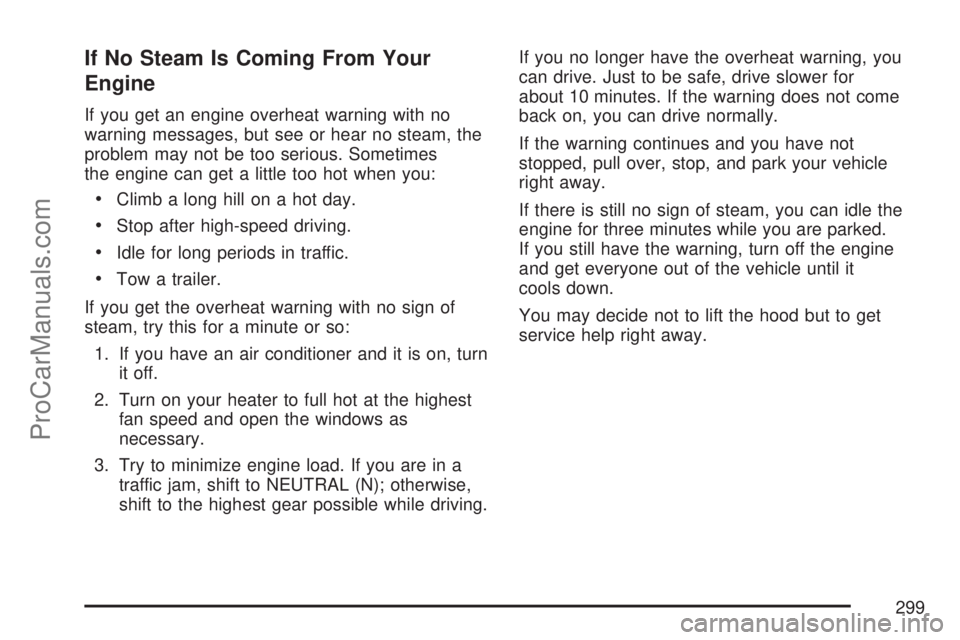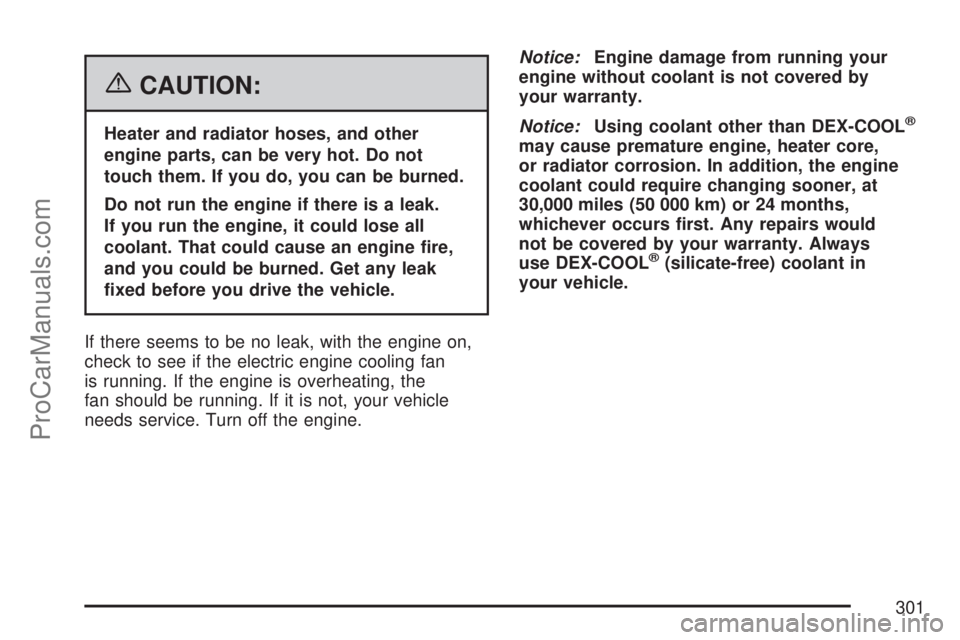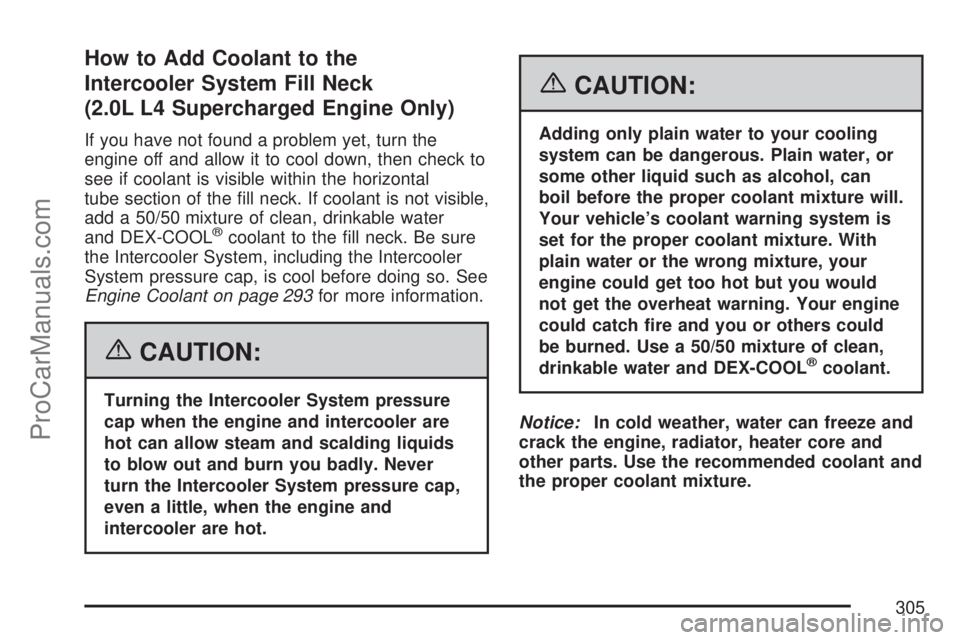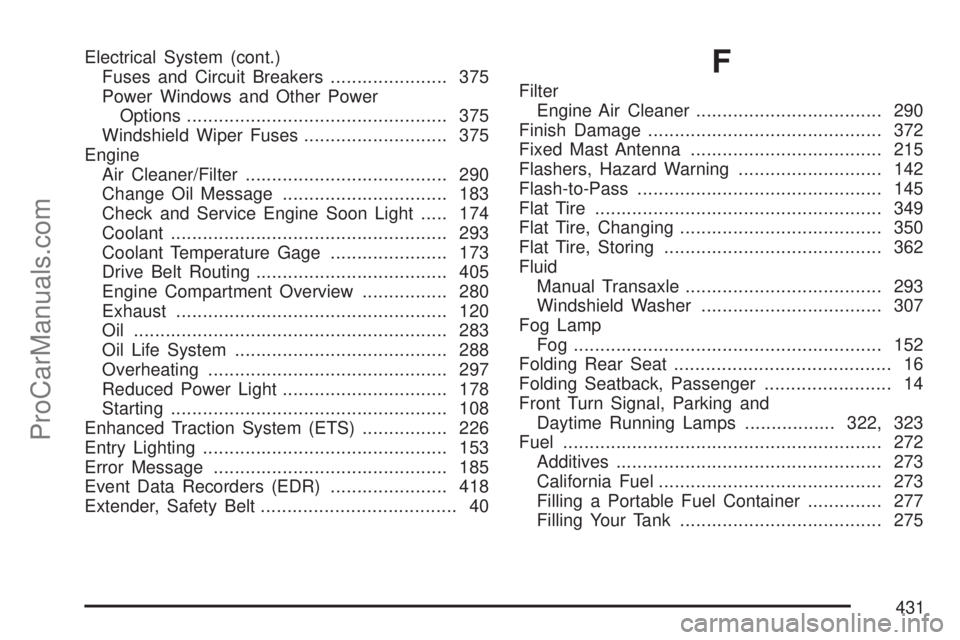engine overheat SATURN ION 2007 User Guide
[x] Cancel search | Manufacturer: SATURN, Model Year: 2007, Model line: ION, Model: SATURN ION 2007Pages: 440, PDF Size: 2.93 MB
Page 296 of 440

Checking Intercooler System Coolant
(2.0L L4 Engine Only)
Park your vehicle on a level surface and turn off
the engine. When your engine is cold, the coolant
level should be just visible within the horizontal
tube section of the �ll neck. When your engine is
warm, the coolant level could be as high as
the FULL HOT line, or a little higher. The FULL
HOT line has an arrow pointing down at it.
Notice:This vehicle has a speci�c coolant �ll
procedure. Failure to follow this procedure
could cause your engine to overheat and
be severely damaged.
Adding Coolant
If you need more coolant, add the proper
DEX-COOL®coolant mixture at the surge tank
and/or intercooler �ll neck, but only when the
engine is cool. SeeCooling System on page 300
for instructions on how to add coolant to the
coolant surge tank and/or intercooler �ll neck.
{CAUTION:
You can be burned if you spill coolant on
hot engine parts. Coolant contains
ethylene glycol, and it will burn if the
engine parts are hot enough. Do not spill
coolant on a hot engine.
When replacing a pressure cap, make sure it is
hand-tight and fully seated.
296
ProCarManuals.com
Page 297 of 440

Coolant Surge Tank Pressure Cap
Notice:If the pressure cap is not tightly
installed, coolant loss and possible engine
damage may occur. Be sure the cap is properly
and tightly secured.
If you replace your coolant surge tank pressure
cap, a Saturn cap is required.
Engine Overheating
You will �nd a coolant temperature gage on your
vehicle’s instrument panel. SeeEngine Coolant
Temperature Gage on page 173for more
information.You also have a check gage message and a
transaxle �uid hot message. SeeCheck Gage
Message on page 184andTransaxle Fluid
Hot Message on page 183.
Notice:Driving with the CHK GAGE message
displayed in the message center and the
Engine Coolant Temperature Gage on your
instrument panel in the red zone could cause
your vehicle to overheat. Your vehicle could
be damaged and the damages might not
be covered by your warranty.
297
ProCarManuals.com
Page 298 of 440

If Steam Is Coming From Your Engine
{CAUTION:
Steam from an overheated engine can
burn you badly, even if you just open the
hood. Stay away from the engine if you
see or hear steam coming from it. Just
turn it off and get everyone away from the
vehicle until it cools down. Wait until
there is no sign of steam or coolant
before you open the hood.
CAUTION: (Continued)
CAUTION: (Continued)
If you keep driving when your engine is
overheated, the liquids in it can catch �re.
You or others could be badly burned.
Stop your engine if it overheats, and get
out of the vehicle until the engine is cool.
Notice:If your engine catches �re because
you keep driving with no coolant, your vehicle
can be badly damaged. The costly repairs
would not be covered by your warranty.
298
ProCarManuals.com
Page 299 of 440

If No Steam Is Coming From Your
Engine
If you get an engine overheat warning with no
warning messages, but see or hear no steam, the
problem may not be too serious. Sometimes
the engine can get a little too hot when you:
Climb a long hill on a hot day.
Stop after high-speed driving.
Idle for long periods in traffic.
Tow a trailer.
If you get the overheat warning with no sign of
steam, try this for a minute or so:
1. If you have an air conditioner and it is on, turn
it off.
2. Turn on your heater to full hot at the highest
fan speed and open the windows as
necessary.
3. Try to minimize engine load. If you are in a
traffic jam, shift to NEUTRAL (N); otherwise,
shift to the highest gear possible while driving.If you no longer have the overheat warning, you
can drive. Just to be safe, drive slower for
about 10 minutes. If the warning does not come
back on, you can drive normally.
If the warning continues and you have not
stopped, pull over, stop, and park your vehicle
right away.
If there is still no sign of steam, you can idle the
engine for three minutes while you are parked.
If you still have the warning, turn off the engine
and get everyone out of the vehicle until it
cools down.
You may decide not to lift the hood but to get
service help right away.
299
ProCarManuals.com
Page 301 of 440

{CAUTION:
Heater and radiator hoses, and other
engine parts, can be very hot. Do not
touch them. If you do, you can be burned.
Do not run the engine if there is a leak.
If you run the engine, it could lose all
coolant. That could cause an engine �re,
and you could be burned. Get any leak
�xed before you drive the vehicle.
If there seems to be no leak, with the engine on,
check to see if the electric engine cooling fan
is running. If the engine is overheating, the
fan should be running. If it is not, your vehicle
needs service. Turn off the engine.Notice:Engine damage from running your
engine without coolant is not covered by
your warranty.
Notice:Using coolant other than DEX-COOL®
may cause premature engine, heater core,
or radiator corrosion. In addition, the engine
coolant could require changing sooner, at
30,000 miles (50 000 km) or 24 months,
whichever occurs �rst. Any repairs would
not be covered by your warranty. Always
use DEX-COOL
®(silicate-free) coolant in
your vehicle.
301
ProCarManuals.com
Page 302 of 440

How to Add Coolant to the Coolant
Surge Tank
If you have not found a problem yet, check to see
if coolant is visible in the surge tank. If coolant
is visible but the coolant level is not at the cold �ll
line, add a 50/50 mixture of clean, drinkable
water and DEX-COOL
®coolant at the coolant
surge tank, but be sure the cooling system,
including the coolant surge tank pressure cap, is
cool before you do it. SeeEngine Coolant on
page 293for more information.
{CAUTION:
Steam and scalding liquids from a hot
cooling system can blow out and burn
you badly. They are under pressure, and if
you turn the coolant surge tank pressure
cap — even a little — they can come out at
high speed. Never turn the cap when the
cooling system, including the coolant
CAUTION: (Continued)
CAUTION: (Continued)
surge tank pressure cap, is hot. Wait for
the cooling system and coolant surge
tank pressure cap to cool if you ever have
to turn the pressure cap.
{CAUTION:
Adding only plain water to your cooling
system can be dangerous. Plain water, or
some other liquid such as alcohol, can
boil before the proper coolant mixture will.
Your vehicle’s coolant warning system is
set for the proper coolant mixture. With
plain water or the wrong mixture, your
engine could get too hot but you would
not get the overheat warning. Your engine
could catch �re and you or others could
be burned. Use a 50/50 mixture of clean,
drinkable water and DEX-COOL
®coolant.
302
ProCarManuals.com
Page 305 of 440

How to Add Coolant to the
Intercooler System Fill Neck
(2.0L L4 Supercharged Engine Only)
If you have not found a problem yet, turn the
engine off and allow it to cool down, then check to
see if coolant is visible within the horizontal
tube section of the �ll neck. If coolant is not visible,
add a 50/50 mixture of clean, drinkable water
and DEX-COOL
®coolant to the �ll neck. Be sure
the Intercooler System, including the Intercooler
System pressure cap, is cool before doing so. See
Engine Coolant on page 293for more information.
{CAUTION:
Turning the Intercooler System pressure
cap when the engine and intercooler are
hot can allow steam and scalding liquids
to blow out and burn you badly. Never
turn the Intercooler System pressure cap,
even a little, when the engine and
intercooler are hot.
{CAUTION:
Adding only plain water to your cooling
system can be dangerous. Plain water, or
some other liquid such as alcohol, can
boil before the proper coolant mixture will.
Your vehicle’s coolant warning system is
set for the proper coolant mixture. With
plain water or the wrong mixture, your
engine could get too hot but you would
not get the overheat warning. Your engine
could catch �re and you or others could
be burned. Use a 50/50 mixture of clean,
drinkable water and DEX-COOL
®coolant.
Notice:In cold weather, water can freeze and
crack the engine, radiator, heater core and
other parts. Use the recommended coolant and
the proper coolant mixture.
305
ProCarManuals.com
Page 431 of 440

Electrical System (cont.)
Fuses and Circuit Breakers...................... 375
Power Windows and Other Power
Options................................................. 375
Windshield Wiper Fuses........................... 375
Engine
Air Cleaner/Filter...................................... 290
Change Oil Message............................... 183
Check and Service Engine Soon Light..... 174
Coolant.................................................... 293
Coolant Temperature Gage...................... 173
Drive Belt Routing.................................... 405
Engine Compartment Overview................ 280
Exhaust................................................... 120
Oil ........................................................... 283
Oil Life System........................................ 288
Overheating............................................. 297
Reduced Power Light............................... 178
Starting.................................................... 108
Enhanced Traction System (ETS)................ 226
Entry Lighting.............................................. 153
Error Message............................................ 185
Event Data Recorders (EDR)...................... 418
Extender, Safety Belt..................................... 40F
Filter
Engine Air Cleaner................................... 290
Finish Damage............................................ 372
Fixed Mast Antenna.................................... 215
Flashers, Hazard Warning........................... 142
Flash-to-Pass.............................................. 145
Flat Tire...................................................... 349
Flat Tire, Changing...................................... 350
Flat Tire, Storing......................................... 362
Fluid
Manual Transaxle..................................... 293
Windshield Washer.................................. 307
Fog Lamp
Fog .......................................................... 152
Folding Rear Seat......................................... 16
Folding Seatback, Passenger........................ 14
Front Turn Signal, Parking and
Daytime Running Lamps.................322, 323
Fuel............................................................ 272
Additives.................................................. 273
California Fuel.......................................... 273
Filling a Portable Fuel Container.............. 277
Filling Your Tank...................................... 275
431
ProCarManuals.com